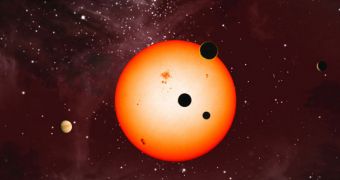Speaking at a NASA conference yesterday, February 2, experts operating the Kepler space telescope announced that they were able to identify a six-planet star system nearby. The extrasolar planets within exhibit some peculiar characteristics, the investigators added.
The parent star in the system is called Kepler-11, which means that all the objects orbiting it will be designated by the same name, plus an extra letter. The planet occupying the first orbit around it will be called Kepler-11b, the next one Kepler-11c and so on.
One of the reasons why this system – located some 2,000 light-years away from Earth – became so interesting to astronomers is that it features a Sun-like parent star at its core. Additionally, data indicate the smaller planet in the system to be just 2.3 times the mass of Earth.
However, NASA experts were clear from the get-go that none of the six objects revolves in the habitable zone of Kepler-11. This is the distance from the star's surface where temperatures are just right to allow for the existence of liquid water.
The system itself is set up in a peculiar manner. Five of the exoplanets within are placed in a tightly-knit configuration around the parent star, whereas the sixth uses a distant orbit much farther away.
“We think this is the biggest thing in exoplanets since the discovery of 51 Pegasi b, the first exoplanet, back in 1995,” explained NASA expert Jack Lissauer.
He is one of the lead authors of the new investigation. The scientist holds an appointment at the American space agency's Ames Research Center (ARC), in Moffett Field, California, Space reports.
“Not only is this an amazing planetary system, it also validates a powerful new method to measure the masses of planets,” explains study coauthor Daniel Fabrycky, who is a postdoctoral fellow at the University of California in Santa Cruz (UCSC).
In a paper accompanying the announcement, which was published in the February 3 issue of the esteemed scientific journal Nature, experts say that the six exoplanets have masses ranging from 2.3 to 13.5 times that of Earth.
Interestingly, despite their size, all the five inner planets would fit inside the orbit of Mercury within our own solar system. These five objects take between 10 and 47 days to complete a year.
“These planets are pretty hot because of their close orbits, and the hotter it is the more gravity you need to keep the atmosphere,” Fortney explains.
“My students and I are still working on this, but our thoughts are that all these planets probably started with more massive hydrogen-helium atmospheres, and we see the remnants of those atmospheres on the ones farther out. The ones closer in have probably lost most of it,” he concludes.

 14 DAY TRIAL //
14 DAY TRIAL //